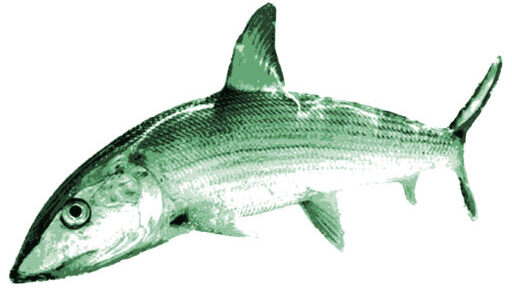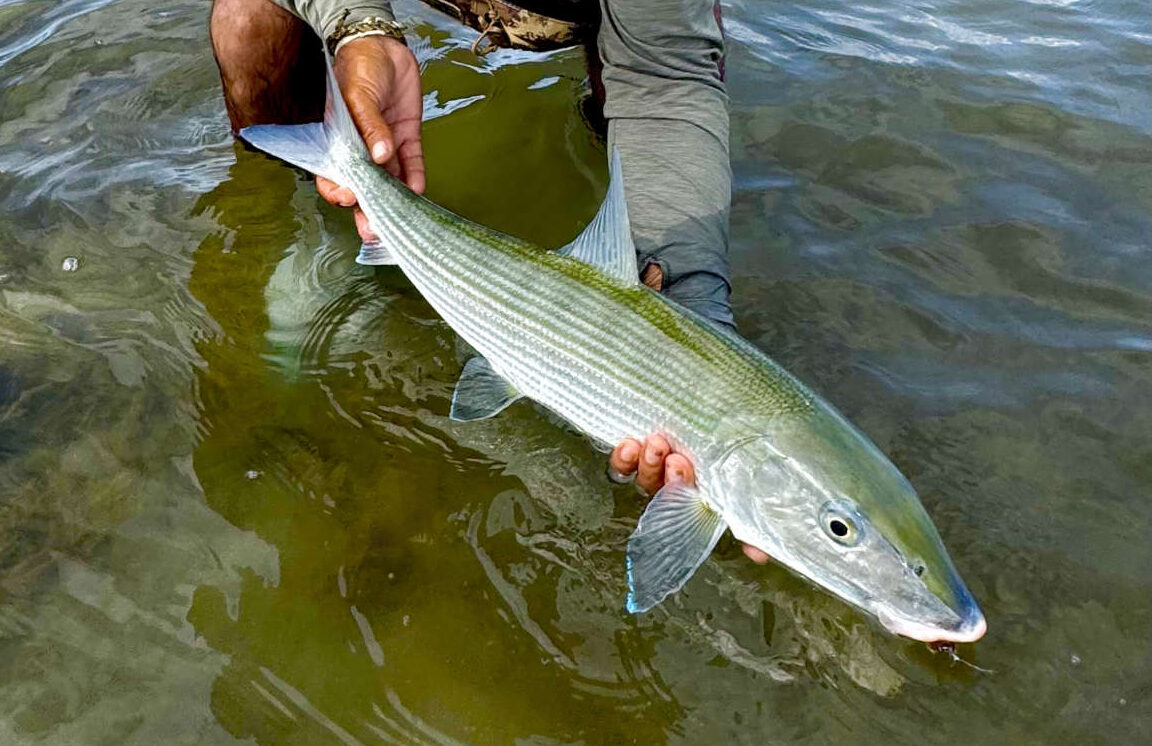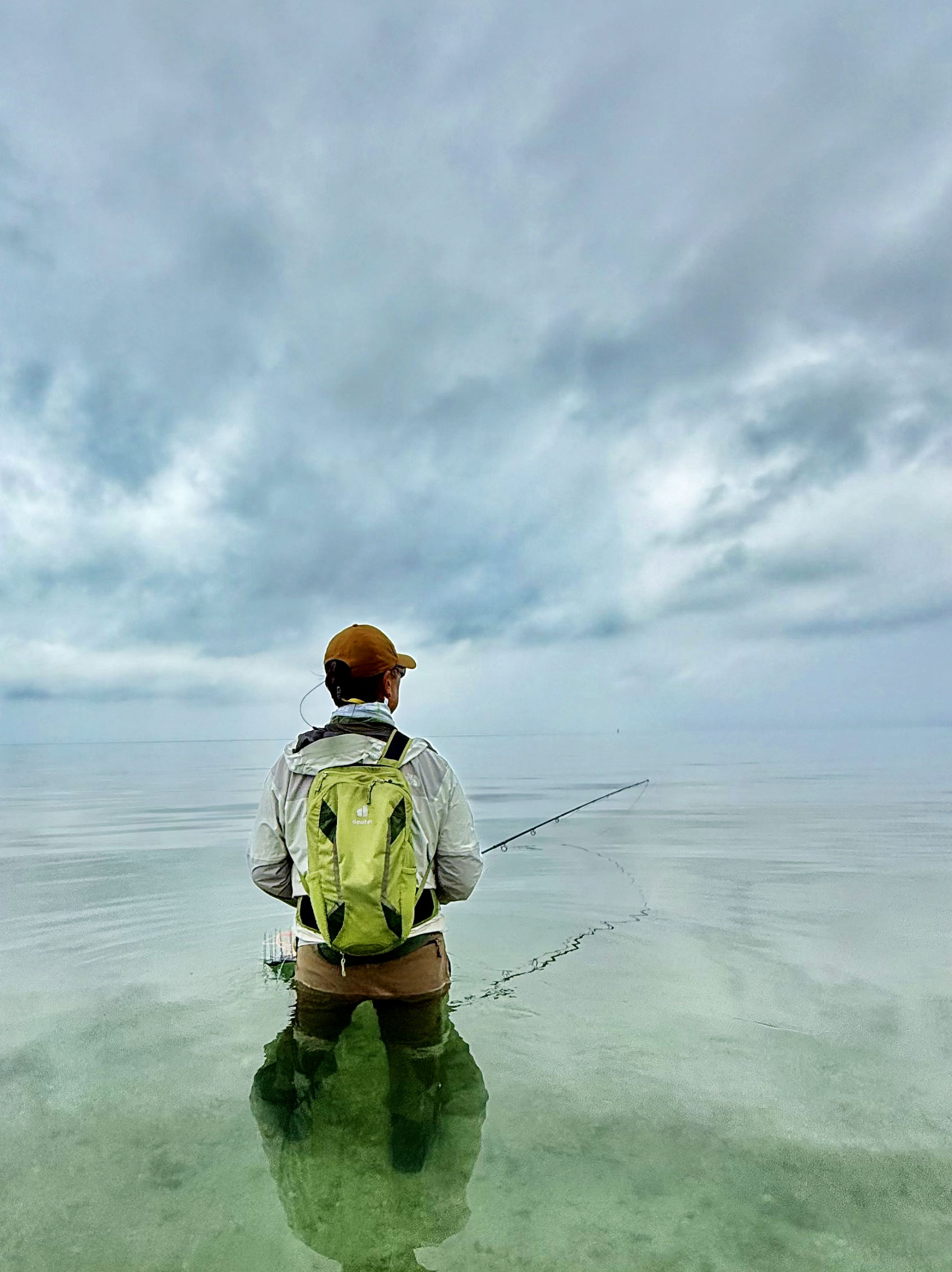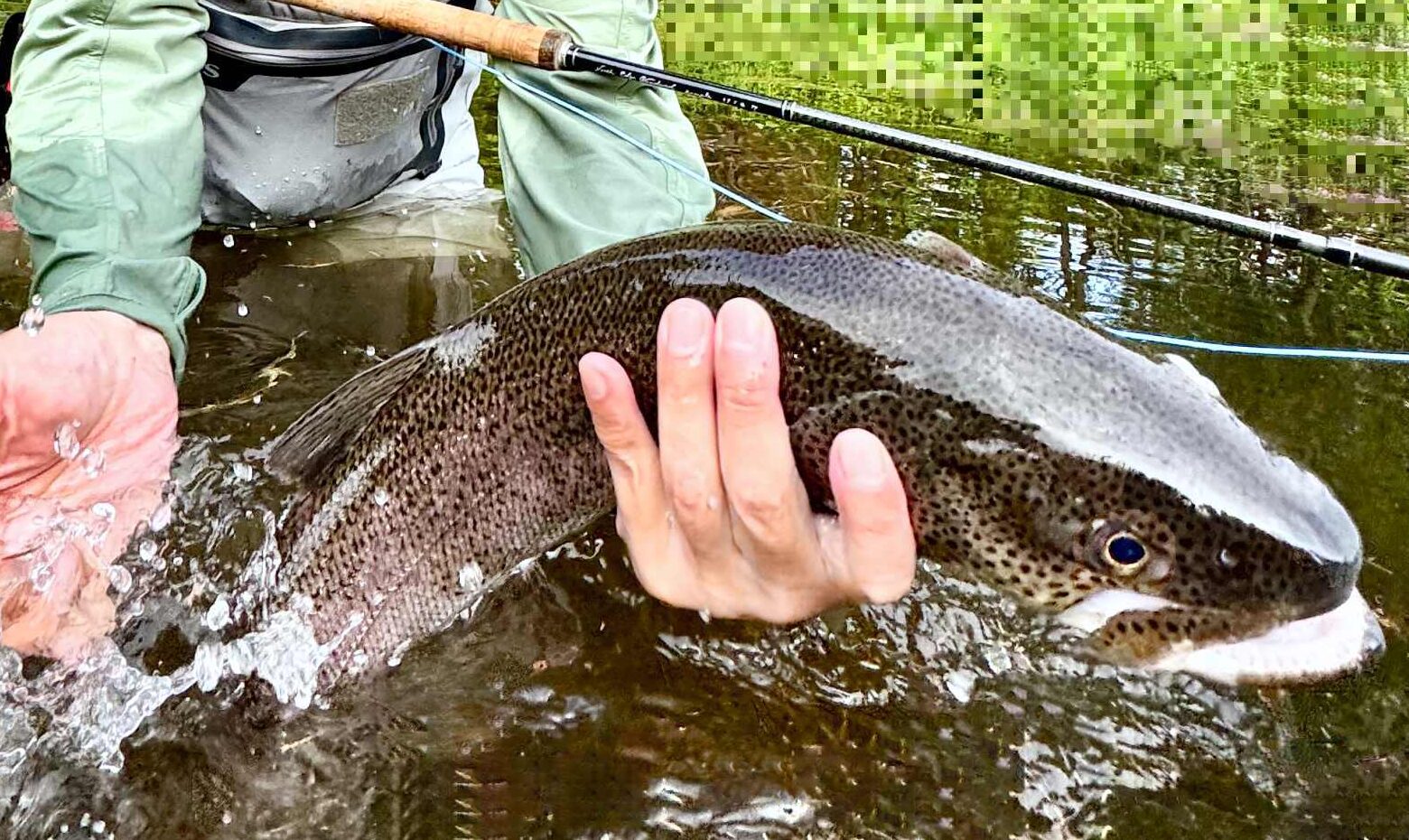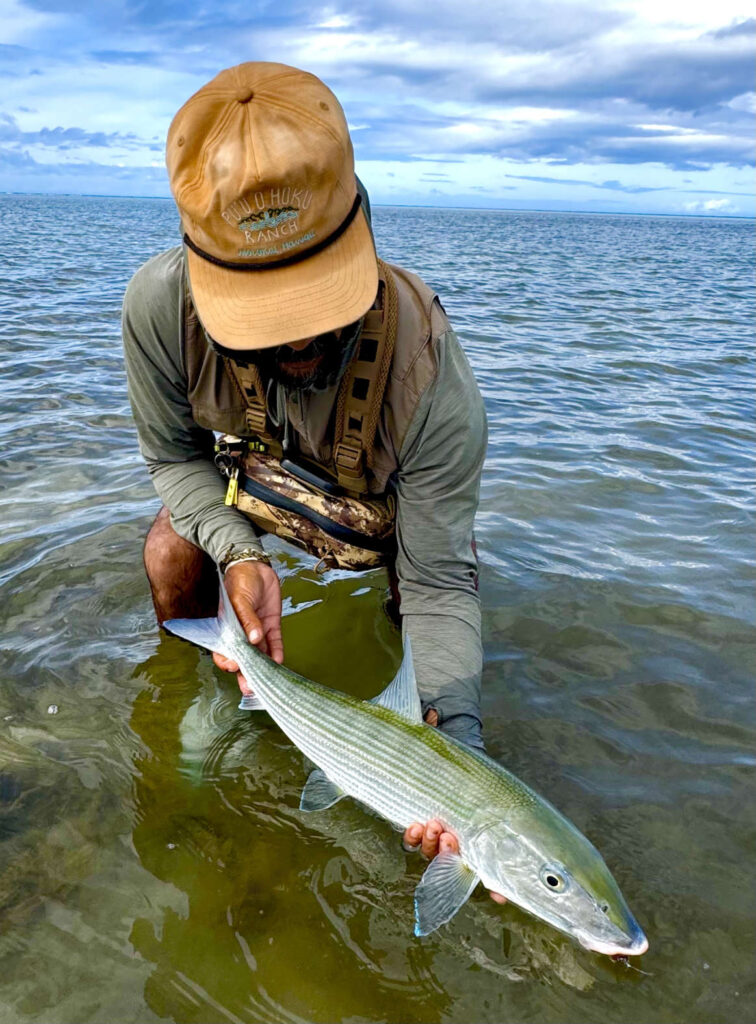
05-25-2025 Scroll down for English
僕にとって毎年のモロカイ島でのボーンフィッシングは大事してきたイベントで、都度、知識の年輪を重ねてきた。
今回は一年で最高となるはずの月齢と潮時の週にピンポイントに狙いを定めて同島に入った。 私が一番頼りにするガイドのジョサイヤに私の今年の戦略の”読み”を明かすと、彼は僕の考えに彼の見地を加えてくれた。
「Hiroの考えは悪くないかもしれない、でも、多分、ボーンフィッシングのピーク日はHiroの考える日に更に3日置いてからだと思うよ。Hiroがピーク日と考える日の前後2、3日は、実はボーンが挙動不明な動きを見せることが多くて、フライを一旦ロックオンしてもソッポ向いてUターンする奴が多いんだ。
モロカイのフラッツをクルーズするボーンフィッシュには、カニやシュリンプ、イソメ類などの餌をふんだんに捕食できる食膳が用意されている。一方で彼らは膝下水深の、言わば2次元平面のフラッツでは、GT、サメ、バラクーダ、海鳥などの外敵の奇襲を受けたら逃げ切れないかもしれないリスクがあることも重々承知していて、常にかなりの緊張下にある。 だからハワイのボーンフィッシュは、原則夜間はフラッツの沖合いを取り囲むリーフを越えて外敵から逃れやすい外海の深みに寝ぐらを求めて移動し、そこで安息の休みをとる。そして日が明けて彼らの求める条件が整うと、また餌を求めてフラッツに戻ってくる。
彼らがフラッツに入って来てから高活性を見せるゴールデンタイムの長さは、日によって異なるのだけれども、Hiroの言う最高と踏んでいる日の前後数日間って、実はボーンがフラッツに留まる時間幅が一番長い数日。つまりボーンにとっては飽食の饗宴に長時間いそしめる滅多にない好条件が揃う時にあたる。 アングラーの目にはボーンフィッシュと長時間をフラッツで過ごせる最高の一日と映るよね!? でも、その時のボーンって既にたらふく餌を食べていて、フライを見つけても縦から横からじっくりフライを観察した挙句にそのまま去って行く奴も多いんだ。その飽食の2、3日が過ぎると、また腹を空かして人間の作った疑似餌、フライ、に果敢に反応してくる。僕の見立てはそんなところかな。」
と彼の考えを説明してくれた。
彼の説明を補足すると、フラッツのガイドの頭の中は更に深い思考が駆け巡っていて、月齢や干満時間の他に、その日の時間と場所毎の潮位、風向き、太陽の位置、雲の動き、釣り師の力量、それまでのターゲットフィッシュの動き、これら全ての情報をファクターインしながら、次は「何時にどこのスポットをどの位の時間を攻めるか」のゲームプランを立てている。データベース・プランニングとディシジョンメイキングを行っているわけで、ここがガイドの力量差の分かれ目の一つでもある。
果たして、今回のボーンフィッシングは、 モロカイ島のボーンフィッシュ事情を知り尽くした彼の言葉通りになった。
初日、僕が最高の日であると踏んでいたその日のボーンは、まるでフライを虫眼鏡で見入るように観察した挙句、ソッポを向いて去って行く奴が、2、3匹いた。それでも何とか2匹キャッチすることができた。
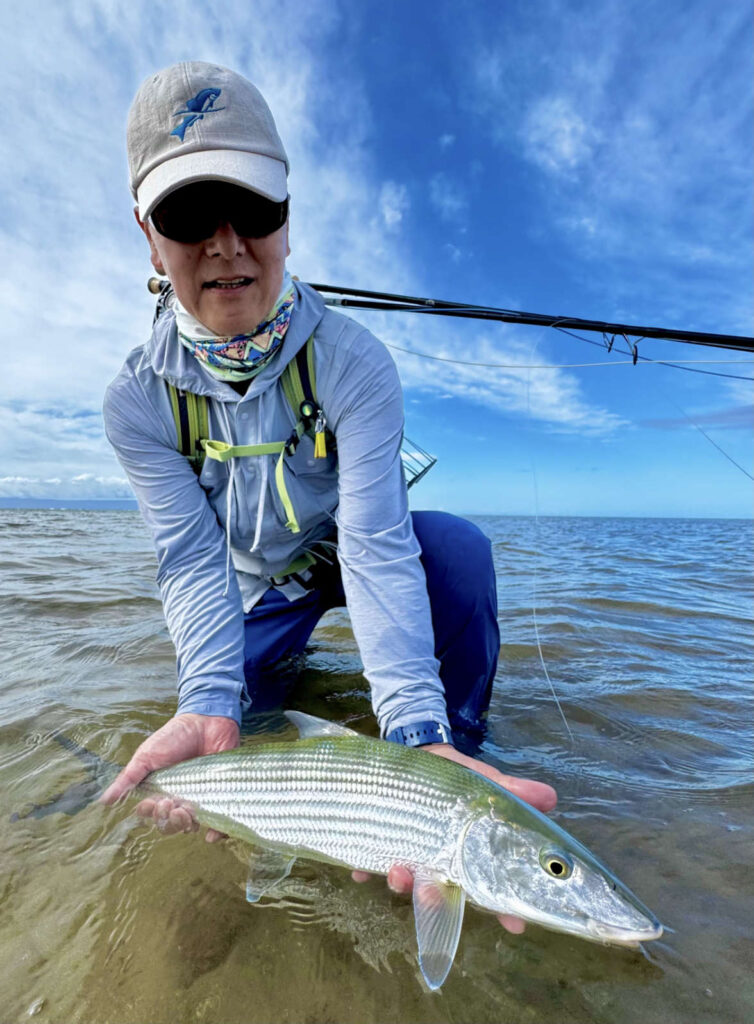
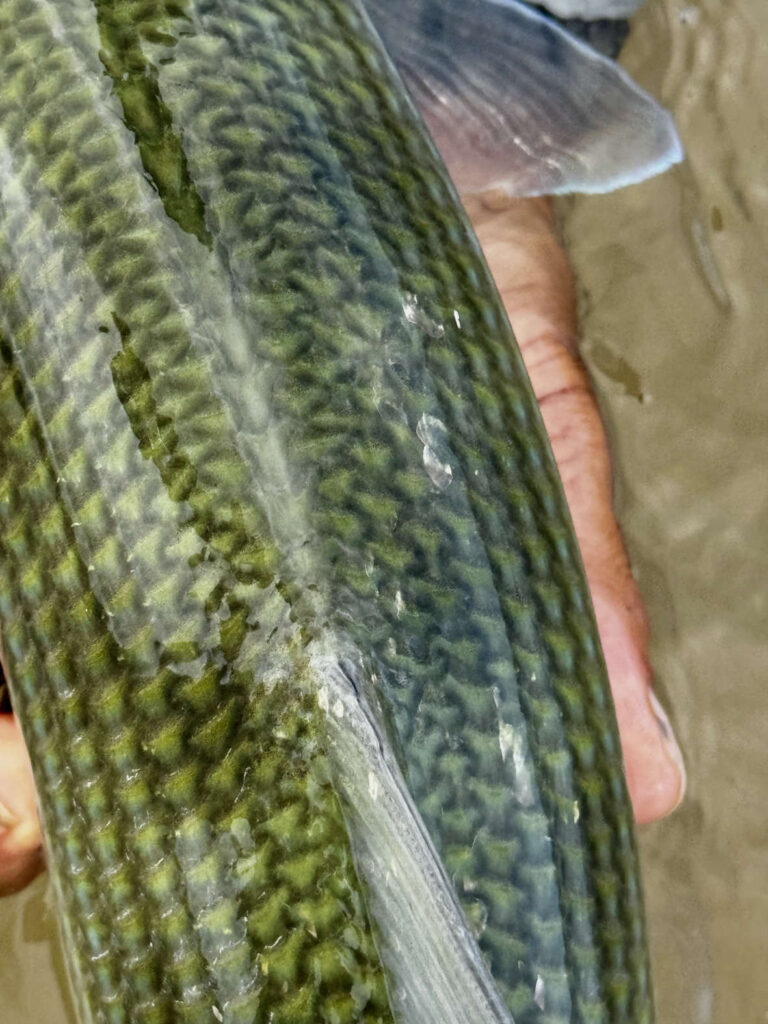
二日目は、朝方いくつかテイリングするボーンを見たが長続きせず、暫く時間を置いてから潮通しの良い場所で多くのボーンがフライに反応した。
そして三日目。ジョサイヤが“いいはず“と予測した日だ。その日は、引き潮下の朝方から広大なフラッツ中にテイリングするボーンの饗宴が見られ、朝一のファーストキャストからいきなりフィッシュオン!それから1時間余りの間に3匹をキャッチした。一匹は確実にダブルディジット(10ポンド)越えの奴だったが、だいたいのダブルディジット越えのボーンの賢さは一級品で、寸前のところでフライを見切られてしまった。因みに、今回キャッチした中で一番大きかったボーンは9.5ポンドあった。
今回の僕にとってのもう一つの収穫は、モロカイでのトレバリーの付き場を見つけてしまったことだ。そこでは3度、ゴートフィッシュ(ヒメジ)の群れをチェイスする20ポンド越えのGTとブルーフィントレバリーに遭遇した。一匹は僕のボーンフィッシュフライを視中に捉えて2mほどチェイスしたのだけど、結局ゴートフィッシュの方に夢中でUターンしていった。次回は、必ず対策を講じてリベンジするつもりだ。
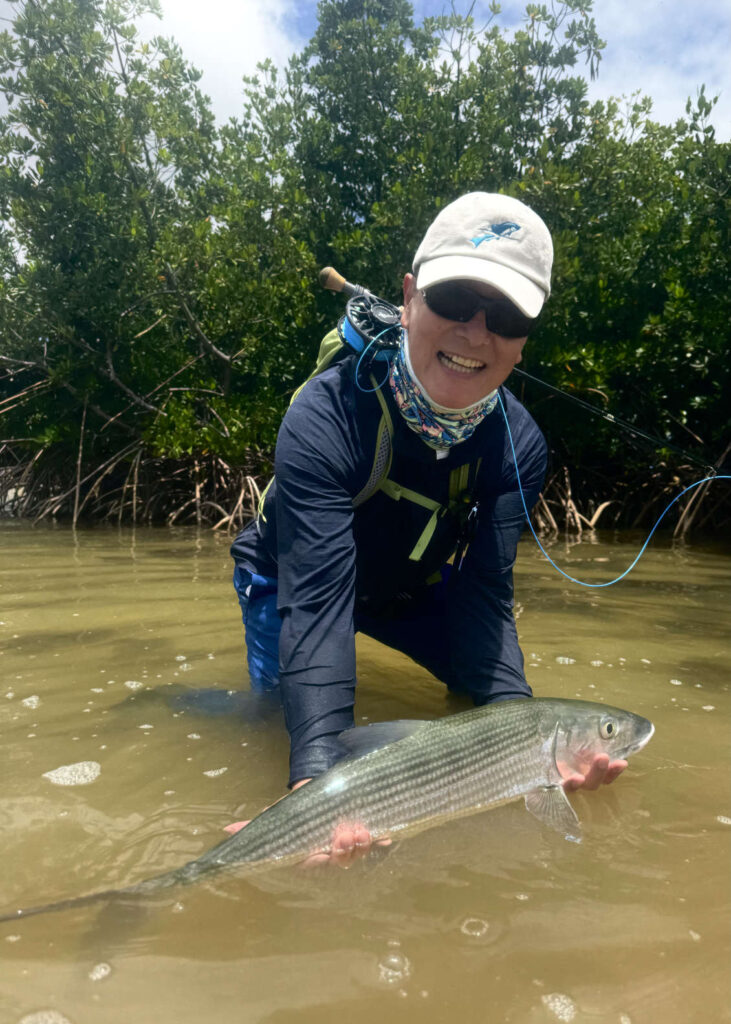
これは、マングローブの中で釣った9.5ポンド。10m/秒の風の中で海水が撹拌されて茶色。9.5 pound fish caught in the mangroves. The seawater turned brown stirred up in the 20 mile/h wind.
ボーンフィッシュは1億3800万年前に誕生した時から、敵から逃れる鋭い感性と圧倒的な遊泳力を磨いてきた。ジョサイヤに言わせると、「その中でもモロカイのボーンフィッシュは、オリンピックのトップアスリート並みに鍛えあげられた剛性なボディを持ち、優勢遺伝子を引き継いだ個体だけが生き残れる世界でも稀有な場所」と言う。ボーンフィッシュは体重あたりで言うと最も強いゲームフィッシュだ。確かに今まで他の場所でモロカイのボーンフィッシュほどの太っとい奴を見たことがない。7ポンドクラスのモロカイボーンなら、数秒できつめに絞ったドラグのリールから100mのラインを引き出してしまう。今回は、150mを簡単に一気に引き出してしまう強者もいた。
あらためて思ったことがあった。ハワイのボーンフィッシュとニュージーランドのブラウントラウトには共通点があると言うこと?だ。
ニュージーランドもハワイも、それぞれの川やフラッツに生息する面積あたりの魚の個体数は、モンタナの川やメキシコのフラッツに比べると少ない。単独行動の魚が多く、いてもペア止まり。スクールで行動する集団にはまずお目にかからない。その分、双方とも魚のアベレージサイズがデカく、筋骨隆々の一匹一匹の魚の”太さ”がハンパない。一方で自然繁殖の魚が100%なのに、不思議なほど小型魚は見かけない点でも共通している。最も豊かな餌場で、最も強い個体だけがそのテリトリーを独占してしまう強者の論理が成立しているのだろう。ニュージーランドもモロカイも自然と生き物の棲息域の絶妙なバランスの上にたつエコシステムが存在しないと、中々あそこまで素晴らしいコンディションと大きさを持つ魚が揃うフィールドにはならないはずだ。
釣りが終わったあとにジョサイヤは笑顔を見せて言った。
「今回Hiroとの釣りは、今年に入って最高の週になった。それに僕自身、こんなにガイドと言う仕事を楽しめた数日を過ごせたのは久しぶりだった。」
彼の言葉は、僕にとってはクライアント冥利に尽きる言葉だ。僕自身、今までのモロカイ島で一番と言っていい最高の数日間だった。
でもここで終わるつもりはない。
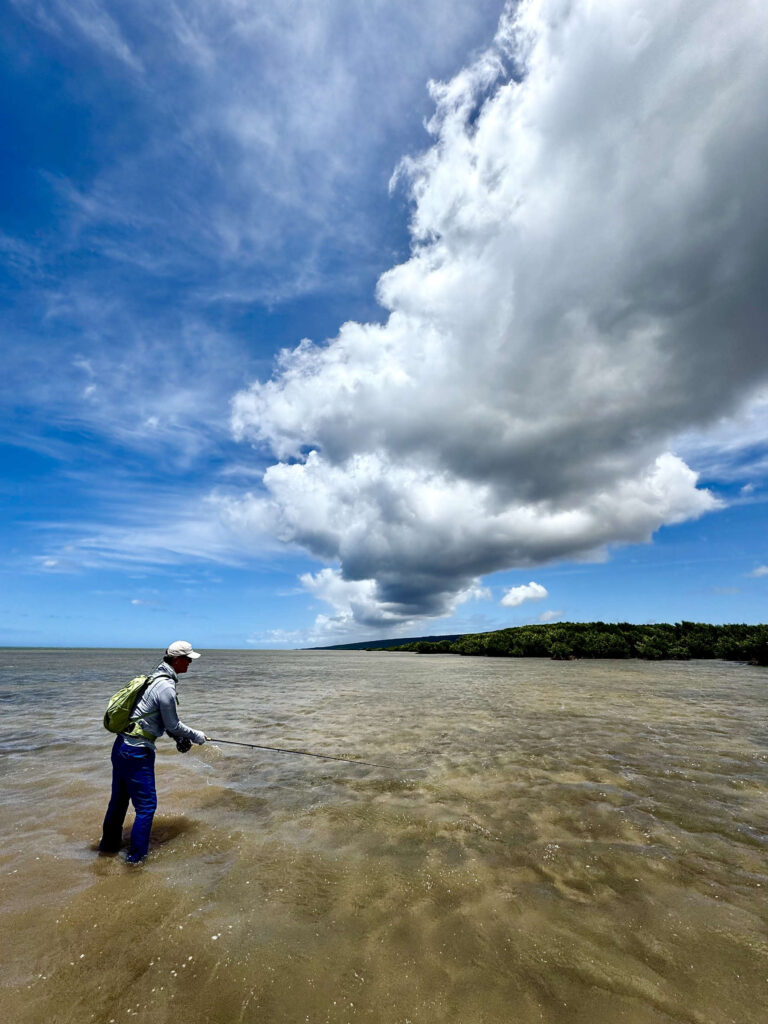
ハワイでは、10m/秒の貿易風の中でキャストするのは、普通にあること。Casting in 20 mile/h trade wind is common in Hawaii.
My bonefishing excursions to Molokai are more than just a trip; each visit adds another ring of growth to my tree of angling knowledge.
This time, I timed my visit to perfection—arriving during what I believed would be the best week of the year, aligned with the ideal moon phase and tides. When I shared my game plans with Josiah, the guide I trust the most, he nodded thoughtfully and added his perspective.
“Hiro,” he said thoughtfully, “your read isn’t wrong… but I think the real peak comes three days after the window you’re aiming for.
Around the days you’ve chosen, bonefish often act strange. Even when they lock onto a fly, many turn away at the last second—almost like they’re toying with us.
The Molokai flats offer a feast—crabs, shrimp, worms—but that abundance comes at a cost. With just knee-deep water to escape into, bones are aware they’re always at risk. GTs, sharks, barracuda, even seabirds—any of them could strike. So, Hawaiian bonefish spend their nights in deeper water beyond the reef, where it is easier to escape from predators, and safety more assured.
Then, as the sun rises and conditions align, they move back into the flats, hungry and hunting. The duration of their ‘golden time’—when they’re actively cruising and hunting—varies by day.
Now, the 2 days front and 2 days behind surrounding the date you think the peak—those are the rare ones when bonefish stay longest on the flats. Sounds like the golden time lasts long for us anglers too!, right? But here’s the catch: they’re so full, they often just inspect the fly from every angle and pass on it. But wait two or three more days—once that feast has passed—they’re hungry again. And that’s when they strike boldly at our flies.
That’s how I see it.”
To add to his explanation in my own words, flats guides have deep thoughts running through their heads, factoring in all the information besides the moon phase, the time of the ebb tide, the tide level at each time and place, the wind direction, the position of the sun, the movement of the clouds, the angler’s skill, and the movement of the target fish up to that point, and then they create a game plan for “what time, which spot, and how long to attack next.” This is database planning and decision making, and it is here that the difference in the ability of the guides is made.
Josiah’s read was spot on.
Day One, the day I had pegged as “the Day”—the bonefish were behaved like overly cautious. A few approached my fly, scrutinizing it like they were holding a magnifying glass, only to turn away. Yet I manage to catch two bonefish.
Day Two, we saw a few tailing bonefish in the morning light but they didn’t last long. After an hour interval they began to feed actively without making curious movements in areas with strong currents.
Then came Day Three—Josiah’s predicted best day—the entire massive flats came alive and we saw tailing bonefish all over the place. It was like a feast of bonefish in the morning light. My very first cast brought an instant hookup. In the next hour, I landed three fish. One of them was surely over ten pounds, but like most double-digit bonefish, it had graduate-level cunning. It inspected the fly, then dismissed it at the very last moment. The largest I landed this time was 9.5 pounds.
One unexpected topic of this trip was discovering a spot where trevally consistently appeared. On three occasions, I watched 20+ pound GTs and bluefin trevally chasing goatfish across the flats. One locked onto my bonefish fly and chased for 6 feet but he U-turned since he was so engrossed in the goatfish.
Next time, I’ll come prepared. That spot now has my full attention.
Bonefish have been around for 138 million years.
According to Josiah, Molokai’s bonefish are elite even among their kind—They are Olympic athlete caliber only the strongest, fastest, and most genetically gifted survive here. In terms of pound for pound, they are the strongest game fish. I’ve never seen bonefish as thick-bodied as those on Molokai. A 7-pounder here can rip 100 meters of line from a tight drag in seconds. On this trip, one pulled 150 meters like it was nothing.
I also came to a new realization that Hawaii’s bonefish and New Zealand’s brown trout share something rare. In both places, fish density per square meter is low compared to places like rivers in Montana or the Mexican flats. Solitary fish are the norm; if you see a pair, it’s a bonus. But what you lose in numbers, but what you do find are trophies. And curiously, you rarely see small ones like 2, 3 pounders.
In both ecosystems, it seems only the strongest individuals get to dominate the best feeding grounds. It’s natural selection on full display, and it takes a finely balanced ecosystem to sustain it.
As we wrapped up our last day, Josiah turned to me with a smile.
“This has been the best week of fishing I’ve had all year,” he said. “And honestly, it’s been a long time since I enjoyed guiding this much.”
To me, that’s the ultimate compliment.
This was, without a doubt, my best trip to Molokai yet.
But I’m not done.
Not even close.
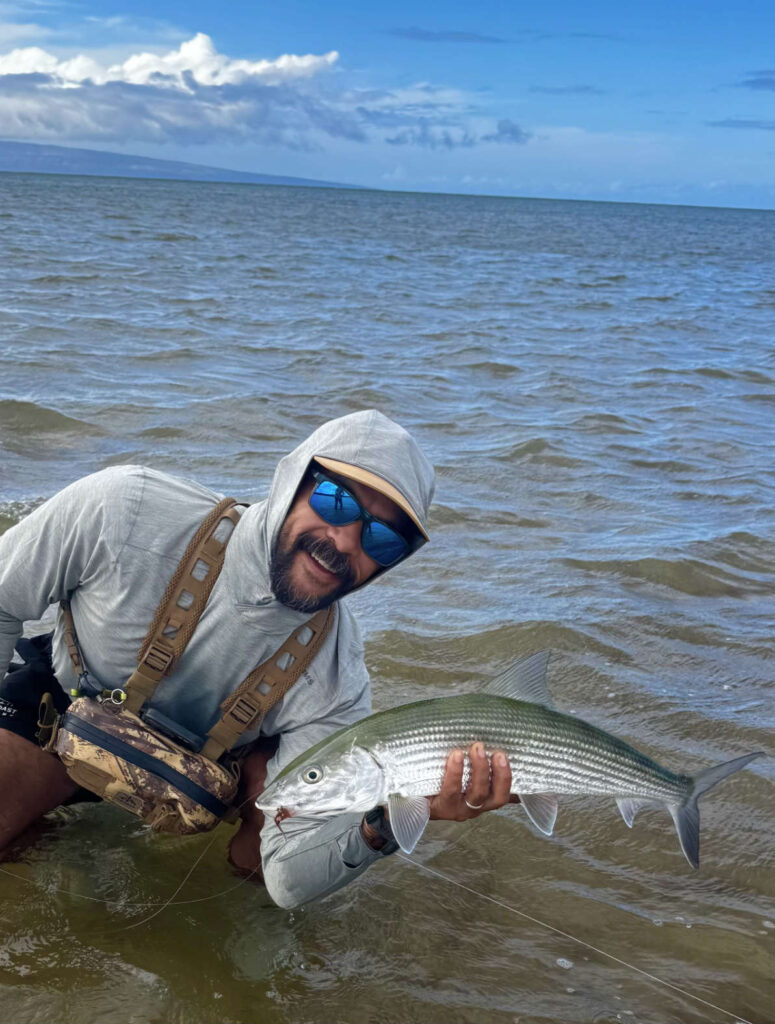
My guide Josiah. He is the best in Molokai.
